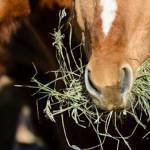Hay: A Staple in Many Horse Diets

Equine diets should be based on forage, and hay is the forage form of choice for stalled horses and those that don’t have access to fresh pasture grass because of season or another factor. There are several ways to prepare or treat hay to make it more appealing to horses or to change its nutrient profile.
Most horses will happily consume dry hay, provided adequate clean water is always available. Hay can be soaked prior to feeding to minimize dust concentrations or to reduce the residual sugar content for horses prone to laminitis or requiring low-sugar diets. Soaking to reduce dust does not require extended immersion. Thirty minutes or less is plenty of time to assure the hay will be dampened and dust-free. Reducing sugar concentrations requires 30 to 60 minutes of soaking, and hot water works more rapidly than cold water. The water containing the sugar should be drained and the hay can either be offered wet or allowed to dry before feeding.
During winter, horses often don’t drink very much as the water can be cold or frozen, and certain types of hay can predispose to impaction colic at that time of year. Along with other measures that keep the horse drinking, feeding wet hay at that time of year may be advisable as this will increase the horse’s water intake.
For most horses, providing free-choice or ad lib hay is best unless the horse has a weight problem. As a general rule, each horse should consume at least 1% of its body weight in forage every day, and ideally this figure will be closer to 1.5%. Therefore, a 500-kg (1100-lb) horse that has no access to pasture should consume at least 5 kg (11 lb) of hay, but would better consume around 7.5 kg (16.5 lb) of hay daily to maintain optimal digestive health. If no concentrate is fed, horses can eat 2 to 3% of their body weight in hay per day, and lactating mares can consume massive amounts of hay.
Mixes of different grasses or legumes can be a great way of providing a variety of hays to your horse. Grass and clover or lucerne (alfalfa) blends are a particularly good way of incorporating some legumes into your horses’ diets without excessive protein or energy intakes that can come from a pure lucerne hay.
Horses that are turned out on pasture for part of the day will probably need some supplemental hay in the stall to bring their total forage consumption up to the desired amount. The proportion of pasture a horse consumes will depend on how much is available and alternative options for forage. As long as each horse consumes at least 1% of its body weight in forage daily, the type of forage does not have significant bearing. If the horse has access to adequate pasture, then hay may not be required. Alternately, if little pasture is available, then hay will be the predominant forage source. At certain times of the year when the pasture is high in water and low in fiber, horses will actually look to eat hay despite an abundance of pasture being available.
Horses can consume up to 3% of their body weight in forage daily if given free-choice access to hay and/or pasture. High-forage diets are the most natural and safest diets to feed horses, but concentrate feeds or supplements are often needed to top up nutrients that are missing from the forage.








